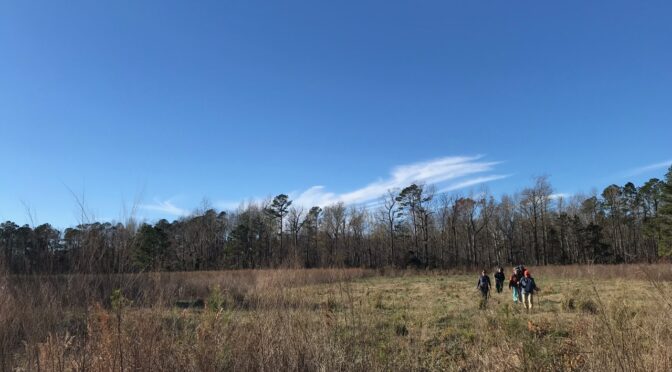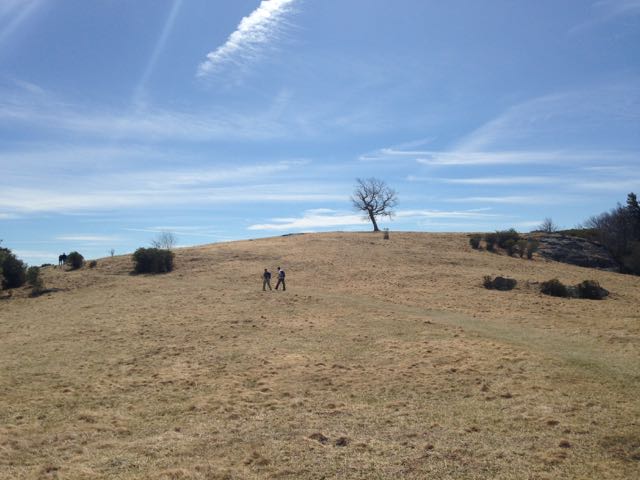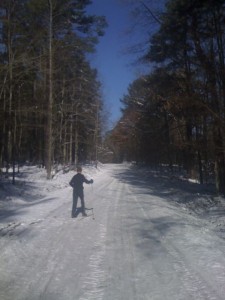Just as a retailer’s thoughts turn to Christmas once Halloween has passed, our thoughts turn to the coast once the fall color starts to fade here in the Piedmont. While I love a summer’s day at the beach, the coast — and coastal plain — are at their most alluring in late fall and winter. A week at a vacation beach house is swell over the summer, but a week at the coast in winter leaves memories that aren’t soon forgotten.
Tag Archives: Coastal Plain
10 of our Favorite North Carolina Winter Hikes
Today we revisit a topic we first wrote in 2012: 10 of our favorite winter hikes. Hikes that, for various reasons, are especially good hiked in cold weather. For some (at the coast, for instance, it’s the only time you can hike them, lest you have an immunity to squadrons of dive-bombing mosquitoes and an unusually high tolerance for things that slither. For others, it may be a view otherwise obscured by a lush, full forest, or for the opportunity to hike in evergreen conditions, or because of exposed terrain that lets winter’s warming sun shine in.
This weekend: Be free (to choose from some great adventures)
Celebrate your independence this July 4 weekend by exercising your right to pick the adventure of your choice. And in this free market of North Carolina adventure, you’ve got plenty of options, from a walk celebrating history at the coast, to mountain firecracker 5Ks, to an adventure of your choosing to the beat of live music.
Leon willing, here’s where you can cross-country ski
It’s days like today that I pat myself on the back for a decision made 13 years ago.
I’d just finished a gorgeous day on the groomed trails at the White Grass ski touring center in West Virginia and was returning my rental equipment.
“How was it?” asked the ski rental guy.
“Incredible!” I oozed. “I can’t wait to go again.”
“You know,” he said, “Our rental skis are for sale.” At a price, it turned out, that was more than I could afford but too good to refuse. I’ve used them a dozen times since; I’m hoping to make it a baker’s dozen tomorrow.
As Winter Storm Leon (sheesh) makes its way up the coast, the prospects are good for cross-country conditions, from the Triangle into the coastal plain. As of this morning, parts of the Triangle were expected to get up to six inches of snow — with points east forecast to get 10 inches or more.
On the right kind of trail, six inches is all it takes to make or decent cross-country conditions. Where might one find the right kind of trail?
Glad you asked.
Options considered for coastal Mountains-to-Sea Trail

My idea of a good time when I can’t be outdoors?
Sitting around a big conference table with the head of the state’s largest trail system and a newly minted map.
Wednesday, Kate Dixon, executive director of the Friends of the Mountains-to-Sea Trail attended a meeting in New Bern about the path the MST would take from New Bern to the Outer Banks. Thursday, she took a few minutes to update me the latest developments on the statewide trail, a 1,000-mile work in progress that will one day run from atop Clingman’s Dome on the Tennessee border across the Tar Heel state to Jockey’s Ridge at the lip of the Atlantic.
A little over half of the trail is done. There’s a 300-mile continuous stretch in the mountains, mostly along the Blue Ridge Parkway, and another good chunk through the Triangle. East of Clayton, though, there’s a long dry spell before you reach the MST’s exciting conclusion along the coast. It was that dry spell that Dixon wanted to talk about.
Specifically, the meeting a day earlier had been about routing the MST through the coastal Croatan National Forest, from New Bern east to the Outer Banks.
“The problem with the Croatan,” she said, “is that it’s wet.”
Indeed. You can’t go far in the 160,000-acre national forest before you run into a wet area known as a pocosin, or upland swamp. Dixon traced her index finger across a number of old roadbeds that seemed to penetrate the forest. Alas, her finger would stop in a pocosin or simply disappear into the mass of coastal jungle growth. Another option, which the FMST isn’t crazy about, is piggybacking on a US 70 bypass around Havelock. Not a lot of esthetic reward in hiking alongside a divided four-lane highway.
Dixon threw a curve ball, though, when she pointed out a sparsely used rail line that runs between the Cherry Point Marine facility near Havelock to Camp LeJeune in Jacksonville, a path roughly perpendicular to a trail coming down the Neuse River. A trail paralleling the Neuse has long been considered the route the MST would take through the coastal plain. The rail line came nowhere close to the Neuse.
“How would that work?” I asked.
“We’re thinking about three types of routes to the coast,” Dixon said.
One would be a paddle route, down the Neuse, to New Bern. Another would be a bike route, following the Neuse as close as possible on less-traveled country roads and passing through the Neuse communities of Goldsboro, Kinston and New Bern. The hiking trail would follow a southerly route, parting ways with the Neuse at Smithfield.
Running a hiking trail along the coastal Neuse is proving problematic on several fronts, Dixon said. In spots, especially in the Let’Lones area below Smithfield, the land is perpetually wet. That’s a problem because the public corridor along the Neuse is only 50 feet wide and much of the surrounding land is privately owned,much of it by folks who have been slow to warm to a public trail running across their property.
So instead, the FMST is looking at dropping the hiking trail south of Smithfield to Bentonville and on to the Bladen Lakes area east of Fayetteville. There, it would make its way east to Jacksonville and pick up the aforementioned rail line, where they might be able to strike an access arrangement. The trail would then tap into the Croatan’s Neusiok Trail and head east to the Outer Banks. Another advantage to the southerly route: there’s more public land to run the trail through.
“It’s just something we’ve started looking at,” says Dixon.


